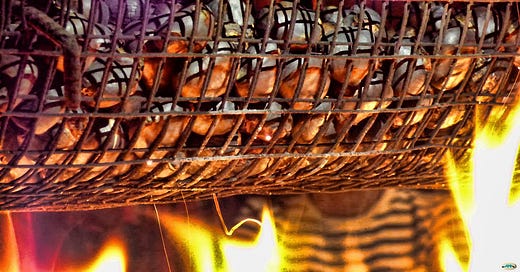Welcome to the Witch’s Kitchen! This is the monthly free full version of the newsletter. To have access to everything we post (and allow us to keep paying our spectacular writers), upgrade to a paid subscription now! Here’s a quick preview of what you’re going to miss throughout November: kitchen witches that can’t cook; historical pieces about salt, sugar, and their uses in witchery; crystal-infused drinks; and more.
Hello, wonderful witches!
How was your Samhain? What did you do? I dressed my poor dog in three different costumes and walked him around the neighborhood a few times. There’s typically a Halloween pet parade in Chicago, but it was canceled this year—so Old Man Ollie and I made our own. Tell me this isn’t cute:
He was basically the star of the neighborhood. If you did anything to celebrate, I’d love to see photos! Reply to this email with an image of what you did or what you wore (or if you have any great pictures of that beautiful blue moon) and I’ll share it on Kitchen Witch’s social media.
Today’s article moves us out of October and firmly into November and the traditions that come with it. Writer Pablo Barragán Grondona is back with a piece that guides us through a fiery festival in Spain.
Magosto: A Feast of Chestnuts and Fire
By Pablo Barragán Grondona

On the first night of November, when winter is near but has not yet arrived, huge columns of smoke rise from the hills of Galicia, Spain, followed quickly by tall fires. They are beacons of light, summoning people and their ancestors’ ghosts alike, to share roasted chestnuts and sweet young wine by the warmth of the flames at night.
These bonfires are lit to celebrate an ancient Celtic tradition called Magosto, a ritual so old and deep-rooted in Spain, that it is performed from Galicia to Catalonia, all across the Basque Country, and as far away as the Canary Islands. It even crosses the western border to Portugal and the eastern one to Occitania.
Magosto is a time where those who have died are remembered and all that is yet to come is embraced. The fire represents the sun—that gives life to all things—and around it, people gather to summon their ancestors’ spirits and guide them to the warm light by telling their life stories, chanting popular songs, and dancing.
The name, dates, and ways of performing the ritual have had small variations over time. In some regions, it is customary that people perform hoaxes and practical jokes on their friends. In others, they jump over the bonfires and use the ashes to paint their faces for good luck.
On the island of Gran Canaria, where Magosto is called Finaos and is celebrated the last week of October, the capital city council organizes parades and kids usually go door to door with paper cones for their neighbors to fill with roasted chestnuts. In some places, Magosto has been replaced by the Christian celebration of All Saints’ Day. In others, it is being forgotten or displaced by Halloween.
What has not changed is that wherever and whenever it is celebrated, freshly harvested chestnuts are roasted over wood fires, and the youngest, sweetest wine of the season, made from the last vintage, is shared. Also, for every handful of chestnuts a person eats, a few are thrown to the fire so that the spirits can feast as well.
This ritual has been traced back as far as Paleolithic times, and as centuries pass, its essence remains unaltered. Magosto signals the end of the warmer months and calls people, and their ancestors’ ghosts, to bond and share a happy moment with each other.
By the end of the night, both the living and the dead should have gathered enough warmth in their bodies, bellies, and hearts to last them through the coldest, hardest, darkest months of the year.
Pablo is an Argentinian journalist and freelance travel writer currently living in the Canary Islands. He travels the world looking for inspiring experiences and amazing stories to share. Follow his journey on Instagram at @pabloenelmundo.
Have you connected with us on social? We’re filling up Facebook, Instagram, and Twitter with Kitchen-Witch-themed posts and shares. Come join us!
Coming Up Next Week…
Next week, we’ll learn about another mystical tradition that invokes the ancestors of Bengali Hindu homes.
See you then!




